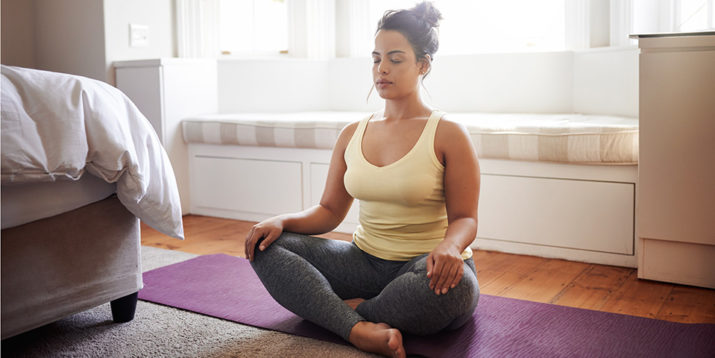How to Meditate Every Day

Believe it or not, I can teach you how to meditate in less than a minute.
You don’t need a complicated method. You don’t need an elaborate breathing technique. You don’t need an unpronounceable mantra.
Instead, just look up at the sky or out the window and take that moment to center yourself. Take a few deep breaths, and step outside the drama of the day. Try this for 30 seconds.
Did you try it? Congratulations. You just meditated!
You’ve just gained a valuable tool to help you deal with the stress of daily life.
Meditation is a very natural thing. It’s something people used to do all the time without even knowing it.
Any time you’re just hanging out by yourself, sitting on the subway, waiting for a doctor’s appointment, or standing in line at the supermarket is an opportunity to meditate.
Of course, if your mind is racing and going in a million different directions, that’s not meditation.
But whenever you just let it all go, enjoy the scenery, take it all in, and “veg out,” in those moments, you are meditating!

But most of us don’t have that anymore.
What do we do now during those moments? We pull out our phones. We no longer give our brain that space.
Thanks to phones and other devices, we’re inundated with information all the time. We’re losing our ability to just exist in the moment and the ability to process our thoughts that this existence gives us.
It’s especially an issue with our kids.
I remember sitting in the back of the car as a kid with nothing to do but stare out the window.
As boring as it may have been, it was an important part of my development. And when I used to walk two miles to school every day, my brain wasn’t overflowing with stuff; it wasn’t hyped up with all these devices kids now stare at all the time.
How to Meditate
The most natural way to meditate is to just be with yourself.
There’s a lot of information about how to meditate and it can be intimidating because we’re raised to follow rules, and we think if we can’t follow those rules, we can’t do it.
That’s your inner saboteur messing with you. All the meditation books, apps, and podcasts are useful tools, but you don’t necessarily need them to get started.
So keep it simple.
You’ve already looked at the sky and breathed for a moment. That was your first step. Make a point of doing something similar a few times during your day, whenever you can.
The next time you’re waiting in the checkout line, don’t open your phone. Instead, focus on your breath. Do this when you’re waiting for your kids after school, or even when you’re at a red light. Just focus on your breath.
Once you’ve mastered taking advantage of those small moments, consider setting aside some time to do it.
When you wake up tomorrow morning, just put your hands on your belly and breathe. It doesn’t have to be 15 minutes; just three to five minutes is fine.
From there, continue practicing in whatever way works best for you.
It can be as simple as setting aside time to sit in a chair, lie down, or go on a walk. Whichever one you do, remember to focus on your breathing.
It doesn’t have to be complicated — you don’t need to change anything about the way you breathe; just focus on it.
You don’t need to judge the way you breathe; you’re just paying attention to it.

The Benefits of Meditation
Meditation is a good way to help you not judge yourself in general.
We all have this “judge” in our head that attacks our behaviors — what we could/should/would have said or done.
And if you’re looking at your phone all day, if you’re constantly processing external information, you’ve eliminated your ability to process these internal thoughts, so they amp up.
But this judge, these destructive thoughts, they aren’t you. It’s not the stuff that’s at your core.
This is stuff borrowed from living life, from years and years of interacting with family, other people around you, work, and school. You weren’t born criticizing yourself this way.
When these thoughts pile up in you, they can be destructive. They make you reach for that donut. They make you skip your workout. They make you angry at your friend. Again, remember, this stuff isn’t you!
The magic of meditation is that it can help you find a way to deal with these negative thoughts.
Once you’re comfortable with taking time to slow down and breathe, set aside a time to meditate and use that time to address your negative thoughts.
Don’t try to get rid of them; watch them in your head, like clouds. You don’t need to rope them back. You also don’t need to go along for the ride and follow these thoughts as they intensify.
Instead, let those thoughts move like clouds past you. If you get caught up in a negative thought, stop and go back to focusing on your breath.
The ability to watch those thoughts like clouds, to not get attached, and instead focus on your breath gives you a new spiritual muscle.
You become an observer, and you realize these thoughts are not you, so you can let them go. You’re no longer in the world of distraction and destruction.
You have a place somewhere inside you that’s calm. It doesn’t mean you don’t care; it doesn’t mean you don’t feel. It just means you’re not reacting to those negative thoughts.
While a daily meditation ritual is wonderful, there’s something very important about applying this practice in your day-to-day life instead of just adding it to your to-do list.
These short moments help you break patterns. They throw a stick in the works.
There might be a couple of clouds that may have been bothering you for a while. These meditative moments give them a chance to pass over you a few times and then they’re gone.
This benefits both you and the people around you. If you’re about to have a shouting match with your son or daughter, take a few moments, breathe, and look back at your child.
You won’t scream. You won’t shout. You’ll talk it out. Your child will see you use this spiritual muscle and learn from you.
Just as it is with exercise and food, everyone has different needs when it comes to meditation.
But at the very least, we all can benefit from looking up at the sky for a few minutes a few times a day and just breathing.
Beyond that, it’s not about what anyone else needs or says you need. The goal is to know exactly what you need and when you need to do it.
